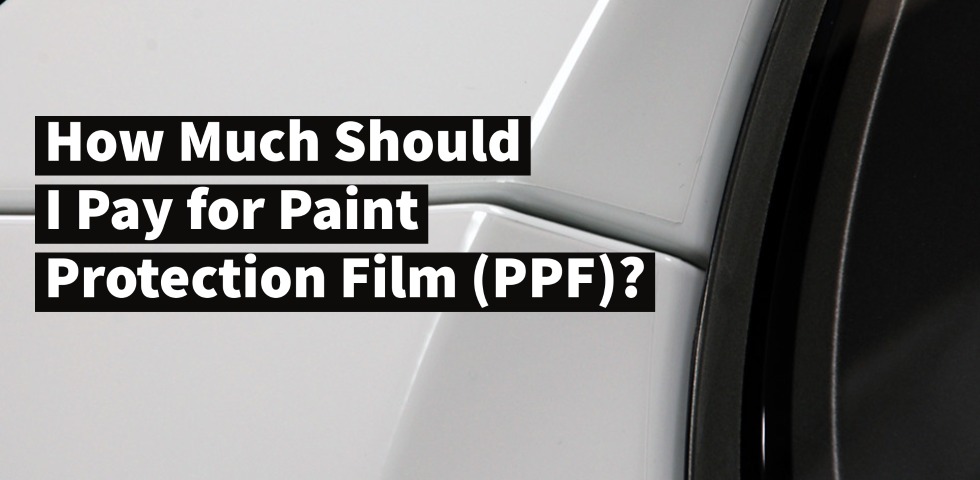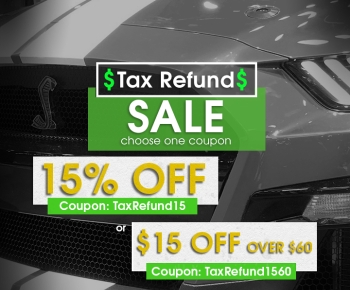How Much Should I Pay for Paint Protection Film?
by Ivan Rajic
Material
Paint Protection Film is used all over the world and there are countless brands. Some film is great, some is crap, some has UV protection, some turns yellow within months. I can’t claim to have tried every film out there, but I have tried all the big, quality brands used in the US as well as a few lower quality films. The better brands/types of PPF have a topcoat that’s pretty UV resistant, self-healing and as of a few years ago hydrophobic. The lower quality films have no topcoat or a very bad one that fades pretty quick. Then there’s everything in between. For the purposes of this article I will simply stick to the quality films without going into much detail. These brands in no particular order, are 3M, Suntek, Stek and Xpel. My main experience is with Suntek and Xpel, both of which have a few different films. It will cost more if you want a film that is hydrophobic or matte, but most clients get regular glossy film that has a great topcoat and self-healing characteristics.
Quality
Installation quality is probably one of the biggest variables in this industry, but that’s a whole article on its own (which I may write pretty soon). First off would be coverage… wrapped edges are the standard for a high quality job, but some edges simply cannot be wrapped. Hood is a panel that can normally be wrapped all around (other than the sharp corners of course). Fenders can usually be wrapped on top into the hood jamb as well as into the wheel well, sometimes even into the door jamb if it’s not too tight. However it can’t be wrapped where it meets the bumper since it simply butts up against it. This edge of the fender is where quality and coverage come into play. I’ve seen Paint Protection Film cover a panel where it’s so far on the edge that it’s extremely difficult to tell it’s even applied. On the other hand there are installs where it’s not only as far away as 1/4″, but also very wavy. The closer to the edge and the straighter the cut, the better the quality of the install. Some installers use pre-cut patterns and others what we call “bulk” cutting or custom installs. A really good installer can do a better job with patterns than an average installer with a custom install, so as you can imagine there is a VERY wide range of PPF installs around the country. In my personal and professional opinion, good quality is where the film edge is pretty close to the panel edge (1/16″ is pretty great of a gap), not wavy and there are no cuts in the paint. Even if the gaps are a little wider, there is still film on the paint and it’s doing a great job protecting it, so as long as the customer is happy with the job who am I to say it’s “bad quality”. In short, good quality will cost more and that usually consists of straight cuts close to the panel edges, wrapped edges where possible and no installation marks in the film. Bad quality will cost less and that’s normally wavy film edges, some stretch marks in the film or worst case, cuts in the paint. Bad quality PPF install is still better to have than chips in the paint, but of course you should try to find an above average installer.
Location
Not much to explain here… If you’re in a huge metropolitan area with tons of supercars, competition and demand, the price will be on the high end. If you’re in a rural area in the middle of nowhere with a couple installers the price will be lower. This is of course not a guarantee as there are VERY expensive installers in some rural areas and extremely cheap installers in larger cities, but it holds true for the most part. Price differences between such areas don’t necessarily correlate with quality… You may get an amazing job for a very cheap price in an area with no demand and a very bad job for a lot of money in a big city.
Vehicle
The car you drive obviously plays a role in pricing. Flat and simple panels are very easy to cover with Paint Protection Film. Curved and complex surfaces can be extremely difficult to install and lead to a lot higher pricing. Then there’s trim! A lot of cars like newer BMW, Audi, Range Rover, etc. have a LOT of painted trim on the exterior, especially on the front end that most clients protect. Many of these newer bumpers have painted splitters, fog light surrounds, grille and mirror stalks (some mirrors with stalks are 4-7 pieces!). These areas can be tricky to install and take a lot of time, so that will obviously increase the cost.
So How Much Should I Pay?
Best way to answer this is to give a few examples what we charge at LUSTR Detail, but also give my opinion of what’s too expensive or too cheap. Keep in mind, we include the prep in our pricing and so do most other shops. If the car is used or really filthy, the cost may go out compared to the same exact car and coverage that doesn’t need too much detailing/prep. The most popular coverage is full front end, which includes the hood, fenders, bumper and mirrors. We do a lot of Porsche cars at LUSTR so that will be a great example to show different pricing due to different complexity on the “same” car. A Porsche 911 GTS would be around $1950. A 911 GT3 would be a bit more since it has a more difficult hood with some holes, maybe more painted trim, etc so say $2100. Then a 911 GT3RS would be closer to $2400 because all the front facing panels are a lot more difficult to install, more stuff to cut around, stuff sticking out, etc. than the standard 911 we started with. To give a few more examples, full front on a Tesla Model 3 would be around $1800, Ford Mustang $2150 and a Maserati MC20 (we just wrapped one recently) would be around $3000 due to difficult panels as well as 2 large bumper panels that need matte film (more expensive). So that’s how much you should pay LUSTR.
We’re a bit higher than average pricing in Chicagoland. From what I know full front PPF prices range from $1200-1500 on the lower end and $1800-2200+ on the higher end. Usually anything lower than $1300 means it’s lower quality work and/or pattern installs. You get decent/good quality for $1400-1600 and should get pretty good quality for $1600-1800+. That said it’s always a gamble as you may get a pretty good job for $1400 vs $1800 or you may get a horrible job for $2000 (we saw this recently, very bad cuts and coverage by a shop who charged more than we do). Unfortunately many larger companies also charge higher prices but use multiple installers, so you may get a really good job or an average job for a premium price. As cliche as it sounds, my best advice is to get good info from the business/installer and see some of their work before committing to anything. If you’re lucky you may come across someone who does a great job but is starting out or has low overhead so they charge a lower price. If unlucky you’ll pay a premium for a below average job and just live with it.
Lastly, keep in mind these are prices associated with the above mentioned films with good reputation. If someone is using a cheap film they may be charging a lot less money so always make sure what you’re getting on your car, check the installer’s reviews and again, try to see the work in person to see what you can expect on your vehicle. Hope that helps!











Will look forward to PPF install quality post!